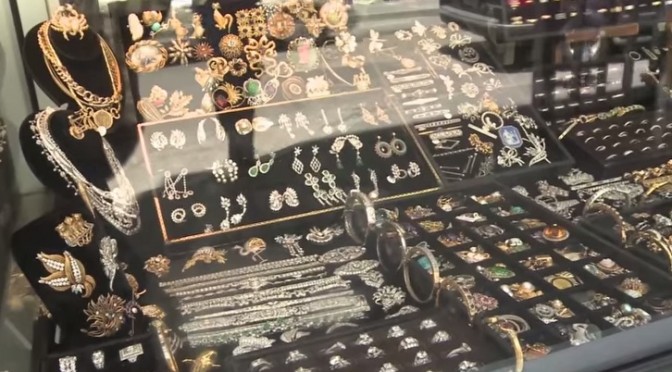by Barbara Nevins Taylor
Valentine’s Day jewelry ads seductively work their magic and get us to think about buying, receiving and wearing something gold or glittery. It’s all good, if you know what you’re doing when you go shopping.
When I worked on TV, the run-up to Valentine’s Day always led us to investigate claims from stores, big and small, and predictably we uncovered some people who didn’t sell what they advertised. In the stores with questionable practices, we frequently found that some gold jewelry didn’t weigh as much as claimed. And in some, we found so-called gold jewelry that wasn’t gold at all.
So it’s a good idea to take care when you shop. And that’s why we put together this tip sheet on how to avoid Valentine’s Day jewelry scams.
Here are 6 Valentine’s Day Jewelry Tips
1. Decide how much you want to spend in advance so that you can avoid getting pushed into buying something that costs more than you had in mind. Sales people are often persuasive, maybe too persuasive.
2. Think in advance about the type of jewelry that you’d like to buy. This will allow you to be in control and avoid feeling overwhelmed when you get to the jewelry counter.
3. Don’t buy anything on impulse. Take time to think about it and maybe even comparison shop.
4. Research the stores where you think you’ll shop. Check the store’s reputation online. Ask friends or relatives for recommendations.
5. Study up to learn the terms that jewelers use. What’s 14K, 18K, 22K, for example. Once you understand what the jeweler is talking about, you’ll get an idea whether what you want to buy is worth the price.
6. Understand the refund and return policies before you buy. Can you get your money back, or must you exchange it for something else? Make sure you get a receipt and that the phone number is visible on the receipt. Sales receipts should have information about the jewelry including a gemological report from a laboratory.
The Jewelers Vigilance Committee offers this excellent information about jewelry:
Diamonds
-
The Four C’s are the criteria used to value a diamond. Ask about the carat weight, color, clarity and cut (cut refers to the quality of cut, not the shape).
-
Ask if the diamond(s) have been treated in any way (i.e. fracture-filled, laser drilled) and whether or not the treatment is permanent.
Colored Gemstones
-
Is the gemstone natural, lab-created or an imitation?
-
 Has this gemstone been treated? If so, how?
Has this gemstone been treated? If so, how? -
If treated, is the treatment permanent and has the treatment affected the gemstone’s value?
-
What is the country of origin of the gemstone?
-
Is special care required?
Pearls
-
Are the pearl(s) natural or cultured?
-
Has the pearl been dyed to enhance or change its color?
-
If the pearl is dyed, is the treatment permanent? Did this affect the value?
-
Is special care required?
Precious Metals
-
In addition to the specifics about precious metals, make sure that jewelry containing precious metal(s) is marked in compliance with the law.
-
The item’s karatage must be identified to you in some way (verbally, through signage, etc.).
-
If an item is stamped to indicate the quality of metal it contains, it must have a trademark in close proximity to the quality mark. (A trademark is a symbol stamped next to the quality mark and may be initials or a logo to identity the make of the item.)
-
Platinum
-
Items containing 950 parts per thousand (95%) may be marked as platinum.
-
 Items that are between 85% and 94% platinum must be marked with the platinum content. Examples: 900Pt, 850Pt.
Items that are between 85% and 94% platinum must be marked with the platinum content. Examples: 900Pt, 850Pt. -
Items containing less than 85% platinum must detail the platinum group metal. Example: 750Pt200Irid. Total parts must equal 950 (95%).
Note: Platinum group metals are: Platinum, Palladium, Rhodium, Iridium, Ruthenium and Osmium.
-
Gold
-
10 karat gold is the minimum fineness of gold that may be sold as gold in the U.S. Jewelry under 10kt fineness may not be sold as gold.
-
Jewelry is made of many different types of gold: solid gold, gold plate, gold filled, gold overlay, gold electroplate, gold flashed/washed or rolled gold plated.
-
Silver
-
Silver/Sterling Silver means that 925 parts per thousand (or 92.5%) of the item is made of pure silver.
-
Silver plate describes a product made of base metal and layered (or plated) with silver.
-
Silver coins contain 900 parts per thousand (or 90%) pure silver.
If you have an issue with a jeweler and he or she won’t resolve the problem, you can file a complaint with the FTC, the Better Business Bureau, the Jewelers Vigilance Committee’s Alternative Dispute Resolution Service, or your state Attorney General.
![]()




One thought on “How to Avoid Valentine’s Day Jewelry Scams”
Comments are closed.